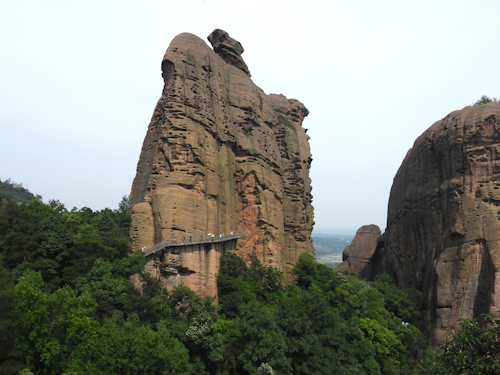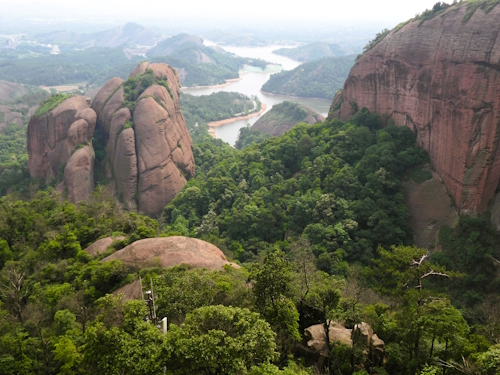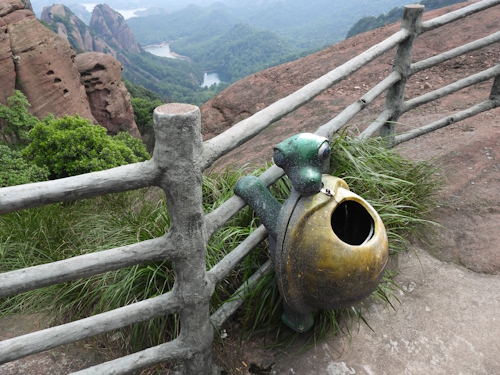Blog WHS Visits
WHS #904: China Danxia
China usually doesn’t have much trouble inscribing sites, but it did have a hard time with China Danxia. “Danxia” is an elusive subject, even Wikipedia isn’t able to define it in one sentence (it calls it “pseudo-karst” consisting of red-coloured sandstones from the Cretaceous and limited to China). ICOMOS and IUCN couldn’t really wrap their heads around it either – IUCN basically saying there isn’t such a thing as a globally acknowledged Danxia landform and ICOMOS insisting that this should be a cultural site (criterion VI, rich cultural associations) instead of a natural site (criterion VII, natural beauty).
Eight out of the nine locations that comprise the WHS of ‘China Danxia’ have so far stayed unreviewed on this website. I visited a ‘new’ one – the Guifeng section of Longhushan National Park. This site is separate from the main Longhushan park (both in geographical reality and in the inscribed list of components), but they share the same site management and Global Geopark status. The strength of Guifeng is that it is very compact, so you can get a good impression of what Danxia entails within a relatively short amount of time.
Unlike other Chinese mountain WHS, this is not a place to wander endlessly. There is one main trail that everybody follows. Here and there you can choose to skip a specific detour to a peak or an ‘attraction’ (more on those later!), but in general, you all start and end at the same place. I walked 8.7 km in total and the loop took me 3.5 hours with plenty of stops. I went on a Sunday morning and there were many day-tripping families and groups of friends around, but nowhere it got too crowded. Drinks, ice cream and other snacks are sold from stalls along the route.
After some initial climbing of stone stairs, you reach the flat, paved walkways that were attached to the sides of the Danxia ‘inselbergs’. This is the best part of the site, as from there you get panoramic views of the landscape of isolated, eroded peaks, which – when the sun is out – show their red colours well. The name Dan Xia was derived from a Chinese poem and means “vermillion sunglow”.
Despite being a Global Geopark and a natural WHS, there is little explanation on site about the geology of the area. The park is much more geared toward providing a fun day out. As if the landscape itself wasn’t pretty enough, several manmade attractions were added. At the far end of the loop, there is a Glass Skywalk. Closer to the end of the trail, you can risk your life in the sleighing on grass or on the giant water slide. The trail ends at the dock, from where a (heavily overpriced) ‘sightseeing’ boat will take you back to the visitor center. I had opted out of that when I bought my ticket but had to succumb to it in the end as I saw no other trail to walk out.
My visit made me think that these kinds of Disneyfied natural sites prevent Chinese city dwellers from coming in contact with ‘real’ nature. If you look closely, there is some left though, I even saw a few animals when I walked on my own - first a squirrel and later a stick insect crossing the paved footpath. At least the latter made me smile – I had never seen a stick insect run but this one did, perhaps to keep its time out of the bushes as short as possible.
Practicalities
Guifeng is an easy half-day trip from Shangrao, which itself is a good hub for the WHS of Sanqingshan and Wuyishan. Take the fast train to the city of Yiyang from Shangrao (17mins) and from Yiyang railway station you can take bus #2 or a Didi taxi (15mins/40 yuan) to the site, known as ‘Guifeng Scenic Area’ or ‘Guifeng Mountain’. Trains run fairly frequently but with some gaps in between certain departures; I left Shangrao on the 7.30 train and got back on the 13.01 from Yiyang. The site entrance ticket costs 60 yuan (for some reason I did not have to pay this), plus 20 yuan for the shuttle ‘train’ from the visitor center to the start of the mountain trail and 80 yuan for the boat ride.
Els - 26 May 2024


